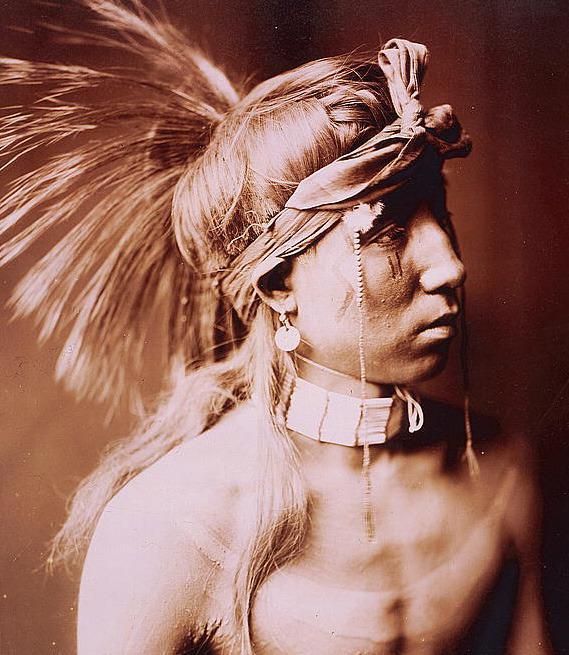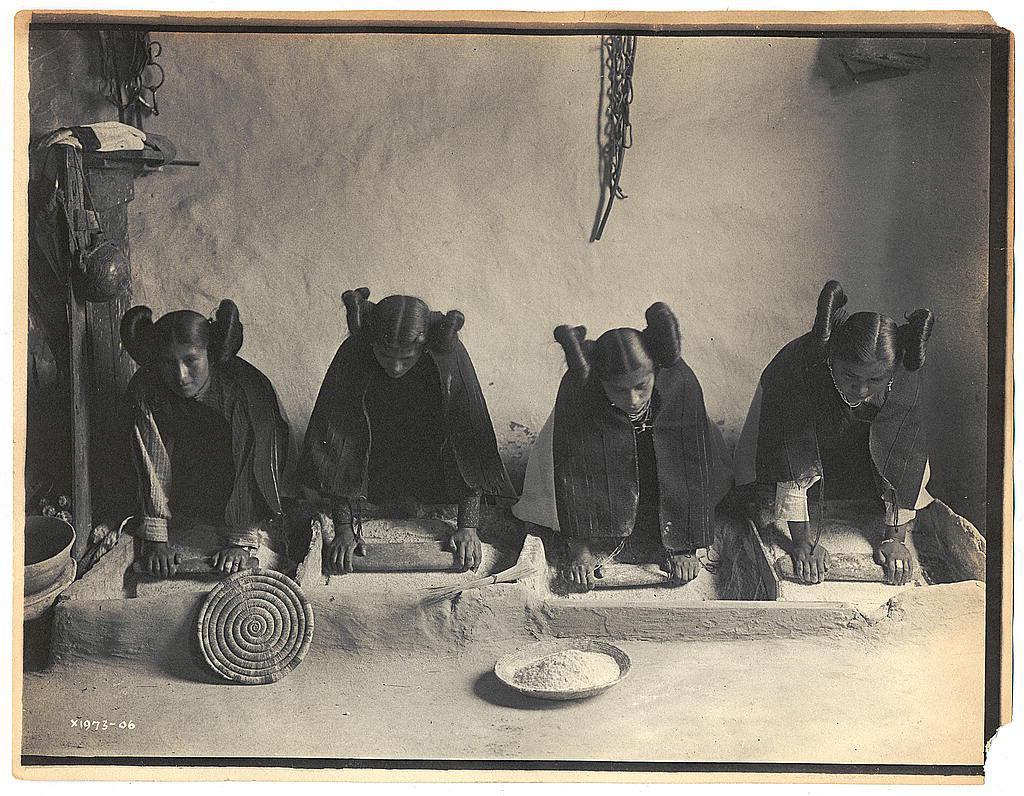
A photo of a Native American man from Edward Curtis' 1930 collection, The North American Indian.
Photo courtesy of the Library of Congress, Prints & Photographs Division, Edward S. Curtis Collection. hdl.loc.gov_loc.pnp_cph.3g03891

A photo of indigenous women rolling out dough from Edward Curtis' 1930 collection, The North American Indian.
Photo courtesy of the Library of Congress, Prints & Photographs Division, Edward S. Curtis Collection. hdl.loc.gov_loc.pnp_ppmsca.050
Wittliff Director discusses Edward Curtis’ indigenous photography collection
One of this nation’s first noted photographers, Edward Curtis, spent much of his career creating images that today are recognized as an attempt to create visual documentation of Native Americans.
His images are controversial in that they were taken by Curtis at a time when indigenous people on this continent were still fighting to hold on to their native lands and increasingly were made to assimilate into ways of life based on Western standards, according to art history and photography experts at Texas State University.
Texas State University Wittliff Collections Director David Coleman recently went on TXST’s “Big Ideas” podcast to discuss Curtis’ photography and the collection, “The North American Indian,” currently on hand at the university. The collection includes images that were published by Curtis from 1907 to 1930.
Many of these images are available for public viewing at the university’s Wittliff Collections, located on the 7th floor of the Albert B. Alkek Library.
In researching the photographer, Coleman said that Curtis stated that his aim in taking the photographs was to chronicle indigenous culture before its disappearance. Still, Curtis and his work has come under scrutiny in recent years for what many point to as the photographer’s use of staging scenes with his subjects and even altering the images later, using techniques available to him in his era.
Prior to coming to Texas State, Coleman was the photography curator at the University of Texas Harry Ransom Humanities Research Center.
Coleman said Curtis won a photo contest, which allowed him to photograph President Teddy Roosevelt’s family at his estate. Following their introduction, Roosevelt wrote a letter of introduction to J.P. Morgan on Curtis’ behalf. It was Morgan who funded the North American Indian photography project.
According to Coleman, Morgan empowered Curtis to make the photographs such that they would appeal to high-end book collectors and universities– eventually producing approximately 500 bounded volumes of images— a massive undertaking for that time.
“It ended up being this amazing idea of trying to, in his mind, document what was a culture that was quickly dying away,” Coleman said. “At this point, they had been relegated to living on reservations. They had decreased from a population that may have been seven to 10 million to a quarter million by the beginning of the century. … There was a very strong effort from the government and society to put the Native American in the rear view mirror.”
Coleman said there was heavy societal pressure on indigenous people to give up their language, music, culture and traditions in the early 1900s. Knowing this, Curtis took as his mission the belief that through documenting Native American stories, songs and images, he could document their existence as significant.
“What I think Curtis was able to do that was especially powerful was … to capture an exact likeness of someone,” Coleman said. “Also, kind of put the viewer in a timeless mode where you’re looking at this person with great honor and great nobility or sometimes just great humility.”
Coleman said Curtis used dry-plate glass negatives, which according to the Cornell University website, were a common technique. These negatives were made by using gelatin mixed with light-sensitive chemicals and other materials, forming an emulsion that could be machine- coated in one step onto large sheets of glass. The glass sheets were then cut to the desired image sizes. Curtis would expose these negatives “dry” in the camera, which is how the process gets its name. Because he chose this method, Curtis was able to develop the negatives on location in his wagon.
Coleman said as photography grew in importance in the United States as an artform deserving of more research and attention, it was in the 1980s that experts started to look at Curtis’ photographs with new appreciation but also with a new amount of criticism.
“He does have them [Native Americans], as far as we know, do some recreations and kind of set up scenes,” Coleman said. “There have been people that definitely noticed … that sometimes a certain trinket or article might kind of go from one tribe to the other while he was publishing them. Sometimes he would just throw a blanket over them … but that blanket kind of goes from tribe to tribe or nation to nation. He also does some retouching.”
Coleman added that with dry plates you can ink out artifacts—a photo- altering technique that stems from this analogue method of photography. Curtis was also known to remove Western items like clocks and suspenders, Coleman explained.
“That’s one image out of the 2,230 … that got published,” Coleman said. “He gets very controversial treatment in the early 80s, but as people start to look more and reflect more, he is photographing some people wearing button shirts [and spectacles in one image], so he doesn’t completely get rid of evidence of Western culture.”
Coleman said he thinks that, in general, Curtis was trying to honor the heritage of his subjects.
“When they were living on reservations, I think they often had trunks of … ceremonial clothing that was passed down to them,” Curtis said. “They would put that on.”
Despite the artistic license taken by Curtis, Coleman said many Native Americans have been said to appreciate his photos.
“Because it's the only record of their ancestor right, and they’re typically beautiful portraits and very respectfully done.” Coleman said. “There’s a lot of writing in these books, on top of the photography. You know he’s not shy about editorializing the way that the government has treated these people, so you need the fuller picture to get a better appreciation of where he’s coming from.”
To learn more about the photography of Curtis, and to listen to the podcast, go to news.txst.edu/ inside-txst/big-ideas-podcast/ episode-45.html.











